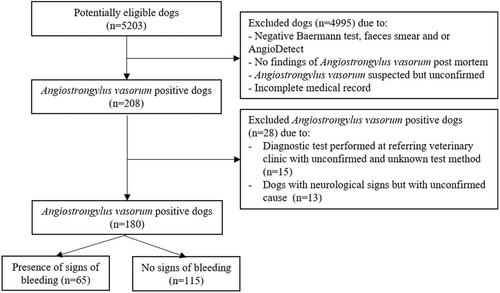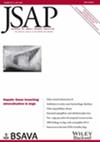Clinical bleeding diathesis, laboratory haemostatic aberrations and survival in dogs infected with Angiostrongylus vasorum: 180 cases (2005-2019)
Abstract
Objectives
Bleeding diathesis is a complication in dogs infected with Angiostrongylus vasorum. This retrospective study investigated clinical and laboratory haemostatic differences in A. vasorum-positive dogs with and without signs of bleeding and impact of bleeding on survival.
Materials and Methods
Demographics, type of clinical bleeding, haematocrit and a range of haemostatic tests, including thromboelastography and derived velocity curves were retrospectively registered from A. vasorum-positive dogs. All parameters were compared between dogs with and without signs of bleeding using univariable analyses. Binomial and multinomial regression models were applied to examine specific indicators in the bleeding dogs. P-values were false discovery rate adjusted, and adjusted P<0.05 was considered significant.
Results
One hundred and eighty dogs entered the study, including 65 dogs (36.1%) presenting with bleeding diathesis. Different types of cutaneous and mucosal bleeding were the most common clinical findings. Twenty dogs presented with neurological signs associated with intracranial and intra-spinal bleeding. One hundred and thirty-seven dogs had haematological and/or haemostatic laboratory analyses performed. Haematocrit, platelet count, thromboelastographic angle, maximum amplitude, global clot strength, maximum rate of thrombin generation and total thrombin generation were decreased, while prothrombin time was prolonged in bleeding dogs. Survival rate of bleeding dogs was lower at hospital discharge (76.9%) and 1 month after diagnosis (66.0%) than in dogs without signs of bleeding (94.8% and 90.1% at discharge and at 1 month, respectively).
Clinical Significance
Several haemostatic aberrations were detected in A. vasorum-positive dogs with bleeding diathesis. Bleeding was identified as an important negative prognostic indicator in A. vasorum-positive dogs.


 求助内容:
求助内容: 应助结果提醒方式:
应助结果提醒方式:


